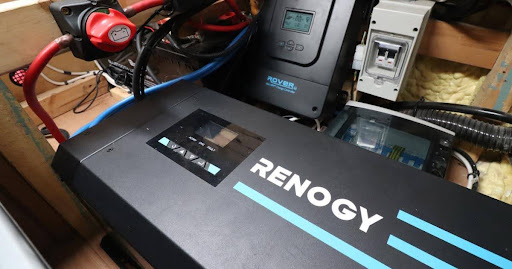Embracing the RV lifestyle means having the freedom to explore the great outdoors while enjoying the comforts of home. However, one crucial element that can make or break this experience is access to reliable power. RV inverters play a vital role in ensuring that you have a steady supply of AC power, allowing you to run your essential appliances and electronics while on the road. In this comprehensive guide, we’ll dive into the world of RV inverters, their importance, types, and how to choose the right one for your needs.
What is an RV Inverter?
An RV inverter is a device that converts the direct current (DC) from your RV’s batteries into alternating current (AC), which is the type of power required by most household appliances and electronics. Without an inverter, you would be limited to using only DC-powered devices or relying on a generator or shore power connection for AC power.
How Does an RV Inverter Work?
RV inverters work by taking the DC power from your RV’s batteries and converting it into AC power through a process called inversion. This conversion process involves the use of electronic circuitry and transformers to change the direct current into an alternating current that mimics the AC power found in your home.
The inverter’s output can be connected directly to AC-powered devices or wired into your RV’s electrical system, allowing you to power appliances and electronics just as you would at home.
Types of RV Inverters
When it comes to RV inverters, there are three main types to consider:
- Pure Sine Wave Inverters: These inverters produce a smooth, consistent AC power output that is identical to the power supplied by your local utility company. Pure sine wave inverters are ideal for running sensitive electronics and appliances that require stable power, such as computers, televisions, and certain motor-driven devices.
- Modified Sine Wave Inverters: Modified sine wave inverters produce a stepped or modified sine wave output, which is not as smooth as pure sine wave inverters. While they are more affordable, they may not be suitable for running certain sensitive electronics or appliances that require a pure sine wave input.
- Inverter/Charger Combos: These units combine an inverter and a battery charger into a single unit. They not only convert DC to AC power but also charge your RV’s batteries from an external AC power source, such as a shore power connection or a generator. This versatile solution can help you manage your power needs more efficiently.
Benefits of having an inverter in an RV
Installing an inverter in your RV offers several benefits that can enhance your overall camping experience:
- Increased Convenience: With an inverter, you can power your AC-powered devices without relying on generators or shore power connections, providing greater flexibility and freedom in your travels.
- Energy Efficiency: Inverters are more energy-efficient than generators, reducing fuel consumption and noise pollution, making them a more eco-friendly and cost-effective option.
- Versatility: Inverters allow you to run a wide range of appliances and electronics, from microwaves and televisions to laptops and power tools, providing greater versatility in your RV lifestyle.
- Quiet Operation: Unlike generators, inverters operate silently, allowing you to enjoy the peace and tranquility of the great outdoors without the noise disruption.
Choosing the Right RV Inverter
With so many options available, choosing the right RV inverter can be a daunting task. Here are some key factors to consider:
- Wattage: Determine the total wattage required by the appliances and devices you plan to run simultaneously, and choose an inverter with a higher wattage rating to accommodate your needs. It’s always better to have a bit of extra capacity than to be underpowered.
- Size: Consider the available space in your RV for installing the inverter, as well as its weight and portability if you plan to move it around frequently.
- Efficiency: Look for inverters with high efficiency ratings, as they will minimize power loss and maximize battery life, ensuring you get the most out of your RV’s battery bank.
- Features: Some inverters come with additional features like remote control, LCD displays, and built-in safety features, which can enhance usability and protection. Evaluate your needs and prioritize the features that matter most to you.
Renogy offers a range of high-quality RV inverters that cater to different power needs and budgets, making it easier to find the perfect fit for your RV setup. Their inverters are known for their efficiency, durability, and user-friendly designs.
How to Install a Power Inverter in an RV
Installing an RV inverter is a relatively straightforward process, but it’s essential to follow the manufacturer’s instructions carefully to ensure safe and proper installation. Here are some basic steps:
- Choose the appropriate location: Determine the best location for the inverter, considering factors such as ventilation, accessibility, and proximity to the batteries. Ideally, the inverter should be installed in a cool, dry, and well-ventilated area.
- Connect to the battery bank: Connect the inverter to your RV’s battery bank using the provided cables, ensuring proper polarity and secure connections. It’s crucial to follow the manufacturer’s guidelines for cable sizing and length to minimize voltage drop.
- Mount the inverter securely: Once the connections are made, mount the inverter securely in the designated location, using the provided mounting hardware or appropriate mounting brackets.
- Connect AC output: Connect the AC output of the inverter to your desired appliances or install an AC outlet for easy access. Ensure that the outlets are properly grounded and protected by circuit breakers or fuses.
- Follow safety precautions: Throughout the installation process, follow all safety precautions outlined in the manufacturer’s manual, including proper grounding, fuse/circuit breaker installation, and ventilation requirements.
FAQs about RV Inverters
To help you better understand RV inverters, here are some common questions and answers:
Q: Can I run my air conditioner with an RV inverter?
A: Most standard RV inverters are not powerful enough to run high-wattage appliances like air conditioners. However, there are larger inverters specifically designed for running air conditioners in RVs, often referred to as “soft start” inverters. These units can handle the high startup current required by air conditioning units.
Q: How long will my RV batteries last with an inverter?
A: The battery life will depend on several factors, including the inverter’s efficiency, the wattage of the devices you’re running, the capacity of your RV’s battery bank, and how frequently the batteries are recharged. Generally, it’s recommended to have a large battery bank or a generator for extended use of high-wattage devices.
Q: Can I use a regular household inverter in my RV?
A: While it’s possible to use a regular household inverter in an RV, it’s not recommended. Inverters specifically designed for RV use are built to withstand the vibrations, temperature extremes, and harsh conditions of RV travel. They also often include features like low-voltage shutoff to protect your batteries from excessive discharge.
Conclusion
RV inverters are an essential component for enjoying the freedom and convenience of RV living. By choosing the right inverter and installing it properly, you can ensure a reliable power supply for your appliances and electronics while on the road. Whether you’re a full-time RVer or an occasional camper, investing in a high-quality RV inverter will enhance your overall RV experience, allowing you to embrace the great outdoors without sacrificing the comforts of home. Happy travels!









